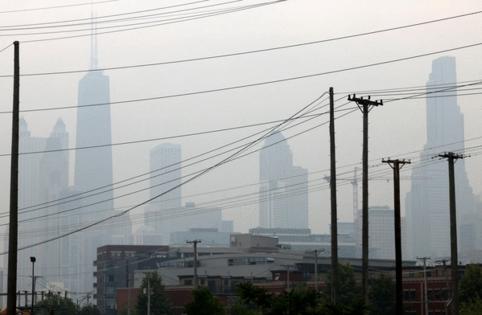Chicago ranked 2nd for worst air pollution in 2023 among major US cities, global report says
Published in Science & Technology News
CHICAGO — Chicago ranked second among major U.S. cities with the worst air pollution in 2023, its average annual concentration of dangerous fine particulate matter almost three times global guidelines, according to a recent report. Even as national standards have tightened, pollution levels in the city still surpassed old regulations.
At one point last summer, Chicago had the poorest air quality recorded among 95 cities in the world. Experts say a major recurring issue and leading cause was pollutants carried by winds across borders and contaminating air elsewhere — such as smoke from forest fires in the Canadian province of Quebec, which blew into Chicago and other U.S. cities.
“Wildfires in Canada devastated air quality, not only in Canada itself,” said Frank Hammes, global CEO of the Swiss air quality technology company IQAir. “But (they) caused a hazardous level of air quality in the United States, where multiple cities in the Midwest and Northeast saw significantly increased levels of polluted air.”
According to the U.S. EPA’s Region 5 office — which includes Illinois, Ohio, Indiana, Wisconsin, Michigan, Minnesota and 35 tribal nations — the wildfire smoke that this portion of the country experienced in 2023 was unprecedented.
“Historically, we have never seen anything like this in our region,” said Krista Thomason, a physical scientist with Region 5’s Air and Radiation Division, who participated in a panel Wednesday on Midwestern air quality. “The western portions of the United States do deal with this more frequently, but for us, it’s a pretty rare phenomenon.”
Sooty smoke from the wildfires reached as far south as Virginia, prompting state and local agencies to issue alerts and caution residents to reduce time outdoors. According to a new IQAir report released Tuesday, the annual concentration of small particulate matter in Chicago last year averaged 13 micrograms per cubic meter of air. In the month of June, it averaged 28.4 micrograms per cubic meter.
This fine particulate matter, or PM2.5, is smaller than or equal to 2.5 micrometers, about 30 times smaller than the width of a strand of human hair. The World Health Organization advises countries to stay below an annual average of 5 micrograms of PM2.5 per cubic meter of air. On the national level, the U.S. Environmental Protection Agency recently lowered annual air quality standards from 12 micrograms to 9 micrograms per cubic meter of air.
For IQAir’s 2023 World Air Quality Report, scientists studied information from over 30,000 air quality monitoring stations and more than 7,800 locations in 134 countries and territories across the globe. More than 17,000 hours of data from each station was grouped by cities and weighted by population.
Because of time differences and depending on the number of monitors in a city, an average worldwide index might not paint a complete picture, according to experts such as Trent Ford, the Illinois State climatologist.
“But in general, to see cities like Chicago — which don’t, citywide, have this kind of perennial problem with air quality — at the top of that list, just gives you an idea of how unusual the conditions are,” Ford previously told the Tribune.
...continued
©2024 Chicago Tribune. Visit at chicagotribune.com. Distributed by Tribune Content Agency, LLC.







Comments